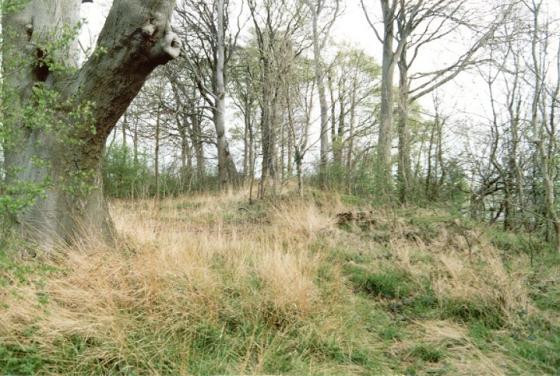The Bully Hills, Tathwell.
These artificial mounds consist of a group of six, lying in close contiguity to one another, and of a detached one removed a few hundred yards from the others, now surrounded by a tuft of trees. They are from 8 to 10 feet in height, and being conspicuously situated on the brow of one of the higher Wold hills, near the village of Tathwell, have long attracted considerable attention, particularly as the remains of two small circular earthworks on an adjoining elevation (consisting of six slightly-raised concentric rings about 180 feet in diameter, usually assigned to the Danish period), in conjunction with these tumuli, have naturally led to the supposition that some conflict between the Saxons and the Danes occurred here, the entrenchments indicating the position of the defendants – the tumuli the graves of the chiefs who fell in the contest.
Other reports have also long been floating about in the vicinity respecting these hills, as retailed by nursery-maids, to the great delight of their juvenile charges, and of course all are connected with hidden treasure. The following reason, for instance, why these mounds are termed “Bully Hills” is really too good to remain unrecorded, although we fear it will not satisfy the doubting mind of every ethnologist and archaeolgian who may come to examine these remarkable earthworks, enquiring what race found them, and when?
It had ever been believed that they covered an immense treasure, and at length a certain farmer, probably by the aid of a judicious dream, was led to dig into one of them, when, after much toil, deep below the surface he found a vast chest, which from its great weight clearly contained some very heavy substance – probably gold! To drag this from its long entombment the said farmer borrowed all the bulls of the district, and yoking them to an iron chain nearly half a mile in length urged them on. The bulls began to pull; but alas! alas! the chain broke – the animals were scattered in the greatest confusion over the hill side – in fact there was a regular “bouleversement” of them, and the mysterious chest sank into the earth deeper than ever, leaving only a reminiscence of this transaction in the term the mounds still bear of “Bully Hills!”
It may be considered presumptuous, perhaps, to doubt the correctness of any part of the above charming bit of local folk lore; otherwise, we might have ventured to suggest that, as several bubbling springs are termed “Bully” springs from the French “bouillant” or boiling, so these hills may have received their appellation from “boule” or “boulet” (a ball), indicative of the rotundity of their outline.
I really don’t think his statements about Saxons and Danes are any better than the pronouncements of “nursery maids” but there we are. From the ‘Stamford Mercury’, 17th July 1857.
















